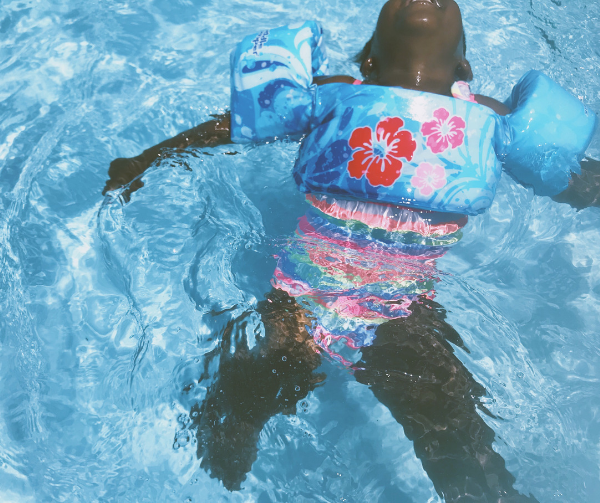
Drowning is the #1 CAUSE of accidental death in children ages 1-4. Accidental. Preventable. It is essential to practice mindful parenting in and around any water.
When we see unsafe behavior around the pool or any body of water, we want to share this statistic with parents and educate them because what they don’t know- they don’t know. But we find ourselves not saying anything. We don’t want to ruin the fun. We think, who are we to tell someone how to raise their child?
But when the number of drownings in Texas soars to 39…something must be said.
1. DO NOT use Floaties. They are dangerous.

When you go to the pool and put floaties (inflatable devices that keep one afloat) on your child, we are not judging you. That is not our place. While we are extremely concerned, we have compassion for you. We know you are tired and you want to rest. You want to plop down in a lounge chair, sip on a cocktail, catch up with friends, check your phone, read a book, read a magazine- anything but be on high alert.
Please DO NOT TAKE A BREAK! Your child’s life depends on it. Please be 100% present when you are around water. When we see you sitting on the side of the pool while your child floats around in a floatie by himself, we don’t want to shame you or guilt you, but we do want to tell you that your child is not only in physical danger, but in developmental danger as well. I want to point out that when your child wears floaties in the water, he is learning poor muscle memory. His body is horizontal; his legs are bicycling; his head is above the water. THIS IS NOT SWIMMING. Please don’t tell him that it is because when you do, you are putting him in extreme danger.
 As he moves himself across the pool, he is gaining false confidence in the water and you are reinforcing it. What you don’t think about is that if he goes into the water without his floatie, he will think he can swim. But he cannot. Allowing him to float around by himself is life-threatening. You are telling him that he can “swim” on his own. I even hear you say, “You’re such a good swimmer!” He believes you. He doesn’t think “I am a good swimmer because I am wearing a floatie. But if I take the floatie off, I will drown.” He just thinks, “I am a good swimmer.” But he is not. He is, in fact, the opposite. He is unsafe and at risk for drowning.
As he moves himself across the pool, he is gaining false confidence in the water and you are reinforcing it. What you don’t think about is that if he goes into the water without his floatie, he will think he can swim. But he cannot. Allowing him to float around by himself is life-threatening. You are telling him that he can “swim” on his own. I even hear you say, “You’re such a good swimmer!” He believes you. He doesn’t think “I am a good swimmer because I am wearing a floatie. But if I take the floatie off, I will drown.” He just thinks, “I am a good swimmer.” But he is not. He is, in fact, the opposite. He is unsafe and at risk for drowning.
As a society, we’ve got it wrong. If your kid doesn’t wear a bicycle helmet, people judge you because you’re putting your child in danger. He needs to wear a helmet for safety. But if you stick your child in floaties and sit on the side of the pool, nobody judges. They act like you are doing a good job because you have “protection” for your child. Well, he doesn’t need protection; he needs to learn how to swim. That cute floatie with Spiderman or a cool turtle on it is not teaching him how to swim. And it’s not an aid for someone that does not know how to swim. YOU ARE THE AID. Your child does not know how to swim, so you need to hold onto him.
2. Teach a Healthy Relationship with Water
 Water is beautiful and magical and it needs to be respected. It is not something to protect your child from, but something to create a healthy relationship with for life. Every time you put a towel over his eyes in the bathtub or tilt his head back so water doesn’t drip down his face, you are doing him a disservice and setting him back in his development. It’s just water. There is no need to “protect” your child from it. If you do, when he does eventually take swimming lessons and the instructor pours water over his head during the first class (which is something he should be used to from infancy), he will probably scream and cry. And you will probably blame the instructor. You may even pull him out of lessons because learning to swim is “just too traumatic” for him, for you, for everyone. You created this situation by training him to dislike water on his face and reinforcing this unsafe, unnatural behavior.
Water is beautiful and magical and it needs to be respected. It is not something to protect your child from, but something to create a healthy relationship with for life. Every time you put a towel over his eyes in the bathtub or tilt his head back so water doesn’t drip down his face, you are doing him a disservice and setting him back in his development. It’s just water. There is no need to “protect” your child from it. If you do, when he does eventually take swimming lessons and the instructor pours water over his head during the first class (which is something he should be used to from infancy), he will probably scream and cry. And you will probably blame the instructor. You may even pull him out of lessons because learning to swim is “just too traumatic” for him, for you, for everyone. You created this situation by training him to dislike water on his face and reinforcing this unsafe, unnatural behavior.
All of this can so easily be avoided. I know that there are battles to choose with children and you want bath time to be fun, so you avoid the drama. But you have to make water a safe place first. Your bathtub routine will affect your child for the rest of his life. Just 5 mindful minutes in the tub can improve your child’s quality of life from infancy.
3. Treat Water like Traffic
 You are vigilant about car seats, crosswalks and street safety. You know streets are dangerous and you teach your child how to find the safest way to navigate them. Do this with water. When your child doesn’t know how to safely cross the street by himself, you hold his hand until he knows how do to it safely on his own. You practice TOGETHER. Over and over and over again.
You are vigilant about car seats, crosswalks and street safety. You know streets are dangerous and you teach your child how to find the safest way to navigate them. Do this with water. When your child doesn’t know how to safely cross the street by himself, you hold his hand until he knows how do to it safely on his own. You practice TOGETHER. Over and over and over again.
When your child does not know how to swim, you need to do the same. You need to practice TOGETHER. Over and over and over again. A floatie is NOT a learn-to-swim device. Puddle jumpers are not either. They are PFDs- Personal Floatation Devices- designed for children that are OUT of the water but near it, as a precaution. So if a child falls in the water, he will float. It is a safety device- like a helmet or a car seat. In case something happens. You wouldn’t stick a helmet on your child that doesn’t know how to cross the street safely and hope for the best. Don’t stick your child that doesn’t know to swim in a floatie and hope for the best. It’s not worth the risk. Be 100% present for your child during this learning process.
4. Make the Water a Safe, Fun Place for the Family
 Before you even go to the pool, make a plan. If your child doesn’t know how to swim, this plan should include you or another adult that knows how to swim, IN THE WATER WITH YOUR CHILD. Within arm’s reach. At all times. No exceptions. When you get to the pool, take a moment, take a breath and become aware of your surroundings before dropping everything and jumping into the water. Model safe behavior. Show your child how to have a safe, healthy, fun relationship with water. Enjoy the family time.
Before you even go to the pool, make a plan. If your child doesn’t know how to swim, this plan should include you or another adult that knows how to swim, IN THE WATER WITH YOUR CHILD. Within arm’s reach. At all times. No exceptions. When you get to the pool, take a moment, take a breath and become aware of your surroundings before dropping everything and jumping into the water. Model safe behavior. Show your child how to have a safe, healthy, fun relationship with water. Enjoy the family time.
We’re sharing this because our children’s lives are just too important. Drowning happens so quickly and so silently. Not everyone has heard the stories straight from the parents whom have lost their loved ones to drowning– how they had no idea and didn’t think it could happen to them. They didn’t know. Nobody told them. So, we’re telling you.
I want your entire family to enjoy the water because it is a wonderful place to connect. Please, take the time to educate yourself about how to keep every member of your family safer in and around water. Please reevaluate how your family interacts with water. We challenge you to make creating a healthy relationship with water a priority for every member of your family.
5. Teach Your Child the Basics
 Enroll your child in swimming lessons. Check out our updated guide to swimming lessons in Austin for a variety of places to take the big splash with your little one.
Enroll your child in swimming lessons. Check out our updated guide to swimming lessons in Austin for a variety of places to take the big splash with your little one.
Kim Shults lives in San Diego, CA where she has been providing customized swim lessons for all ages and abilities since 1991. She is an innovator in swimming instruction for people with autism and those overcoming water phobias. Her successful record of aquatic breakthroughs inspired her to found Face in Water, a non-profit organization that helps individuals develop lifesaving water safety skills. She has a California Teaching Credential in English and is using her curriculum development experience to create swimming and water safety education for families, schools and organizations worldwide.










Great article Kim!